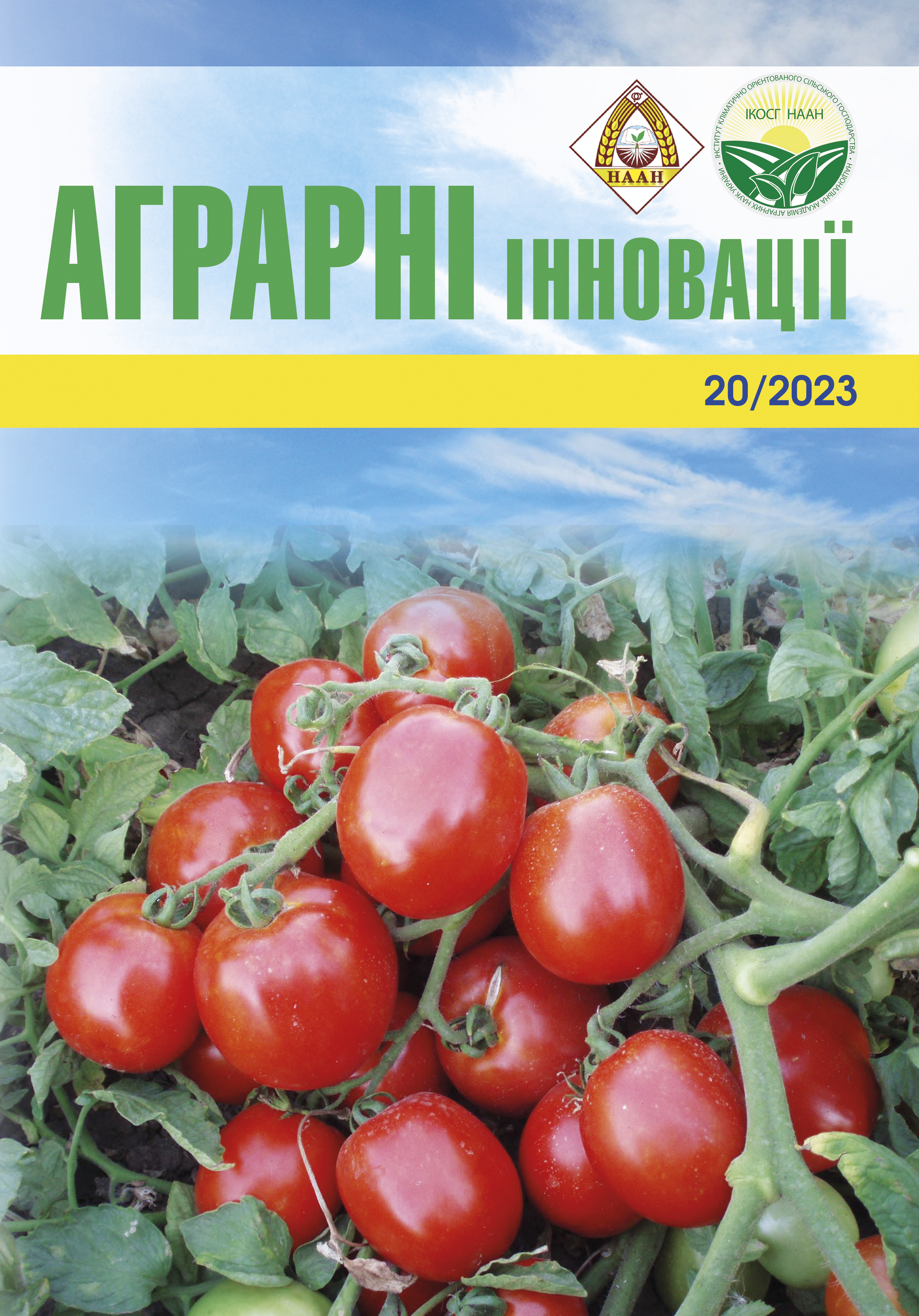Influence of nitrogen fertilization on the elements of crop structure and productivity of spring barley
Abstract
The purpose of the research: to evaluate the productivity of different varieties of spring barley in farm conditions and to establish the optimal doses of nitrogen fertilizers for fertilizing. Research methods: laboratory, field, laboratory and field mathematical and statistical. Climate change, the shortage of organic fertilizers and the high cost of mineral fertilizers once again confirms the importance of the issue of optimal nutrition of spring barley plants. The research on the effectiveness of nitrogen fertilization for the formation of high productivity of spring barley was conducted during 2021–2022 under the conditions of Organic-D LLC on gray forest, medium loamy soils with a slightly acidic reaction of the soil solution. Mid-season spring barley varieties of domestic selection Lofant, Hetman, Vakula and Helios were used in the research. Research results. We have found that the application of nitrogen fertilizers significantly affects the formation of elements of the yield structure and productivity of the studied spring barley varieties. Characterization of the elements of the yield structure, such as the number of grains in the ear and the weight of 1000 grains depends on the biological characteristics of the varieties, growing conditions and the use of nitrogen fertilizers. The highest value of the weight of 1000 grains was observed in the variant with the application of nitrogen fertilizers at a rate of 60 kg. d.p. in the tillering phase of spring barley – Lofant – 42.1 g, Hetman – 41.8 g, Vakula – 41.0 g and Helios – 42.5 g. The number of grains in the ear of the studied spring barley varieties averaged 20.9 pcs. for two years in Lofant, 21.0 pcs. in Hetman, 22.0 pcs. in Vakula and 23.4 pcs. in Helios. The use of nitrogen fertilizers at the rate of N35 provided an increase in the number of grains in the ear by 1.0, 1.1, 1.1 and 2.3, at the rate of N45 by 1.6, 2.9, 2.5 and 4.4, and at the rate of N60 by 2.5, 3.8, 4.2 and 5.8, compared to the control variant (without fertilization). Conclusions. Thus, the use of nitrogen fertilization on spring barley crops can improve the complex of economically valuable traits and significantly increase the yield. The greatest increase in grain yield (1.96 t/ha) of the studied spring barley varieties compared to the control (without fertilization) was obtained in the variant with the use of nitrogen fertilization at a rate of 60 kg of d.p. per 1 ha. The yield level of the studied varieties on this fertilization variant, on average for two years of research, was Lofant – 3.85 t/ha, Hetman – 4.78 t/ha, Vakula – 4.62 t/ha and Helios – 4.84 t/ha.
References
2. Паламарчук В.Д., Доронін В.А., Колісник О.М., Алєксєєв О.О. Основи насіннєзнавства (теорія, методологія, практика): монографія. Вінниця: ТОВ Друк, 2022. 392 с.
3. Полюхович М. М., Вега Н. І. Підвищення продуктивності ячменю ярого шляхом оптимізації мінерального живлення. Агроеліта. 2019. №4. [Електронне видання]. Режим доступу: https://agroelita.info/2019/04/pidvyschennya-produktyvnostiyachmenyu-yarohoshlyahom-optymizatsiji-mineralnoho-zhyvlennya/
4. Іщенко В.А. Вплив мінерального живлення ячменю ярого на продуктивність агроценозу під час сівби після різних попередників в умовах Степу України. Таврійський науковий вісник. 2021. № 119. С. 35–40.
5. Вега Н.І. Ефективність системи удобрення для вирощування ячменю ярого. Агроеліта. 2020. №8 (91). [Електронне видання]. Режим доступу: https://agroelita.info/efektyvnist-systemy-udobrennyadlya-vyroshhuvannya-yachmenyu-yarogo/
6. Шкурко В.С. Вплив погодних умов, попередників і добрив на врожайність сортів ячменю пивоварного. Вісник Полтавської державної аграрної академії. 2012. № 3. С. 167–170.
7. Лень О.І. Забезпеченість рослин ячменю ярого основними елементами живлення залежно від варіантів удобрення. Вісник Полтавської державної аграрної академії. 2010. № 4. С. 182–185.
8. Антонець О.А., Антонець М.О., Бородай В.Д. Вплив мінеральних добрив на урожайність зерна ячменю ярого. Матеріали Х науково-практичної інтернет-конференції «Інноваційні аспекти сучасних технологій вирощування сільськогосподарських культур» присвячена 115 річчю з дня народження професора Є. С. Гуржій. Полтава. 31 березня 2021 року. С. 7–10.
9. Паламарчук В.Д., Каленська С.М., Єрмакова Л.М., Поліщук І.С., Поліщук М.І. Системи сучасних інтенсивних технологій у рослинництві. Вінниця: ФОП Рогальська І.О., 2015. 452 с.
10. Тинько В. В., Поліщук М. І. Вплив на висоту рослин ярого ячменю мінеральних і мікродобрив в умовах Правобережного Лісостепу України. Сільське господарство та лісівництво. 2022. № 2 (25). С. 227–235.
11. Гирка А. Д., Ткаліч І. Д., Сидоренко Ю. Я., Бочевар О. В., Ільєнко О. В. Реакція ярого ячменю на мульчування, добрива та ширину міжрядь. Агроном. 2017. №2. С. 92–96.
12. Ткачук О.П. Вплив позакореневих підживлень на тривалість міжфазних періодів ячменю ярого в умовах правобережного Лісостепу України. Сільське господарство та лісівництво. 2022. № 3 (26). С. 216–224.
13. Методика Державного сортовипробування сільськогосподарських культур (зернові, круп’яні та зернобобові культури) / за ред. В.В. Волкодава. Київ, 2001. 64 с.
14. Мойсейченко В.Ф., Єщенко В.О. Основи наукових досліджень в агрономії. К.: Вища школа, 1994. 335 с.






